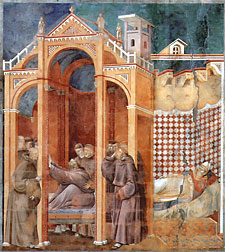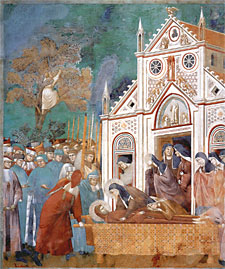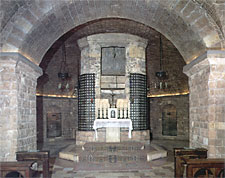St. Francis of Assisi
Not long afterwards Francis, at the urgent instance of Brother Elias, underwent an unsuccessful operation for the eyes, at Rieti. He seems to have passed the winter 1225-26 at Siena, whither he had been taken for further medical treatment. In April, 1226, during an interval of improvement, Francis was moved to Cortona, and it is believed to have been while resting at the hermitage of the Celle there, that the saint dictated his testament, which he describes as a "reminder, a warning, and an exhortation". In this touching document Francis, writing from the fullness of his heart, urges anew with the simple eloquence, the few, but clearly defined, principles that were to guide his followers, implicit obedience to superiors as holding the place of God, literal observance of the rule "without gloss", especially as regards poverty, and the duty of manual labor, being solemnly enjoined on all the friars. Meanwhile alarming dropsical symptoms had developed, and it was in a dying condition that Francis set out for Assisi. A roundabout route was taken by the little caravan that escorted him, for it was feared to follow the direct road lest the saucy Perugians should attempt to carry Francis off by force so that he might die in their city, which would thus enter into possession of his coveted relics.
It was therefore under a strong guard that Francis, in July, 1226, was finally borne in safety to the bishop's palace in his native city amid the enthusiastic rejoicings of the entire populace. In the early autumn Francis, feeling the hand of death upon him, was carried to his beloved Porziuncola, that he might breathe his last sigh where his vocation had been revealed to him and whence his order had struggled into sight. On the way thither he asked to be set down, and with painful effort he invoked a beautiful blessing on Assisi, which, however, his eyes could no longer discern. The saint's last days were passed at the Porziuncola in a tiny hut, near the chapel, that served as an infirmary. The arrival there about this time of the Lady Jacoba of Settesoli, who had come with her two sons and a great retinue to bid Francis farewell, caused some consternation, since women were forbidden to enter the friary. But Francis in his tender gratitude to this Roman noblewoman, made an exception in her favour, and "Brother Jacoba", as Francis had named her on account of her fortitude, remained to the last.
On the eve of his death, the saint, in imitation of his Divine Master, had bread brought to him and broken. This he distributed among those present, blessing Bernard of Quintaville, his first companion, Elias, his vicar, and all the others in order. "I have done my part," he said next, "may Christ teach you to do yours." Then wishing to give a last token of detachment and to show he no longer had anything in common with the world, Francis removed his poor habit and lay down on the bare ground, covered with a borrowed cloth, rejoicing that he was able to keep faith with his Lady Poverty to the end. After a while he asked to have read to him the Passion according to St. John, and then in faltering tones he himself intoned Psalm cxli. At the concluding verse, "Bring my soul out of prison", Francis was led away from earth by "Sister Death", in whose praise he had shortly before added a new strophe to his "Canticle of the Sun". It was Saturday evening, 3 October, 1226, Francis being then in the forty-fifth year of his age, and the twentieth from his perfect conversion to Christ.
The saint had, in his humility, it is said, expressed a wish to be buried on the Colle d'Inferno, a despised hill without Assisi, where criminals were executed. However this may be, his body was, on 4 October, borne in triumphant procession to the city, a halt being made at St. Damian's, that St. Clare and her companions might venerate the sacred stigmata now visible to all, and it was placed provisionally in the church of St. George (now within the enclosure of the monastery of St. Clare), where the saint had learned to read and had first preached. Many miracles are recorded to have taken place at his tomb. Francis was canonized at St. George's by Gregory IX, 16 July, 1228. On that day following the pope laid the first stone of the great double church of St. Francis, erected in honour of the new saint, and thither on 25 May, 1230, Francis's remains were secretly transferred by Brother Elias and buried far down under the high altar in the lower church. Here, after lying hidden for six centuries, like that of St. Clare's, Francis's coffin was found, 12 December, 1818, as a result of a toilsome search lasting fifty-two nights. This discovery of the saint's body is commemorated in the order by a special office on 12 December, and that of his translation by another on 25 May. His feast is kept throughout the Church on 4 October, and the impression of the stigmata on his body is celebrated on 17 September.
In addition to the saint's writings the sources of the history of Francis include a number of early papal bulls and some other diplomatic documents, as they are called, bearing upon his life and work. Then come the biographies properly so called. These include the lives written 1229-1247 by Thomas of Celano, one of Francis's followers; a joint narrative of his life compiled by Leo, Rufinus, and Angelus, intimate companions of the saint, in 1246; and the celebrated legend of St. Bonaventure, which appeared about 1263; besides a somewhat more polemic legend called the "Speculum Perfectionis", attributed to Brother Leo, the sate of which is a matter of controversy. There are also several important thirteenth- century chronicles of the order, like those of Jordan, Eccleston, and Bernard of Besse, and not a few later works, such as the "Chronica XXIV. Generalium" and the "Liber de Conformitate", which are in some sort a continuation of them. It is upon these works that all the later biographies of Francis's life are based.
- 6 -
- The description of St. Francis's Life in the site is short and incomplete. It gives an account of the main facts, but there are a lot of books, which open the personality of St. Francis more deeply.
- The history about St. Francis and Clare you can read in the section «St. Clare»
Francis greets the Sister-Death.
Poor Ladies with St. Clare are taking leave of St. Francis.
The remains of St. Francis were found under this spot












